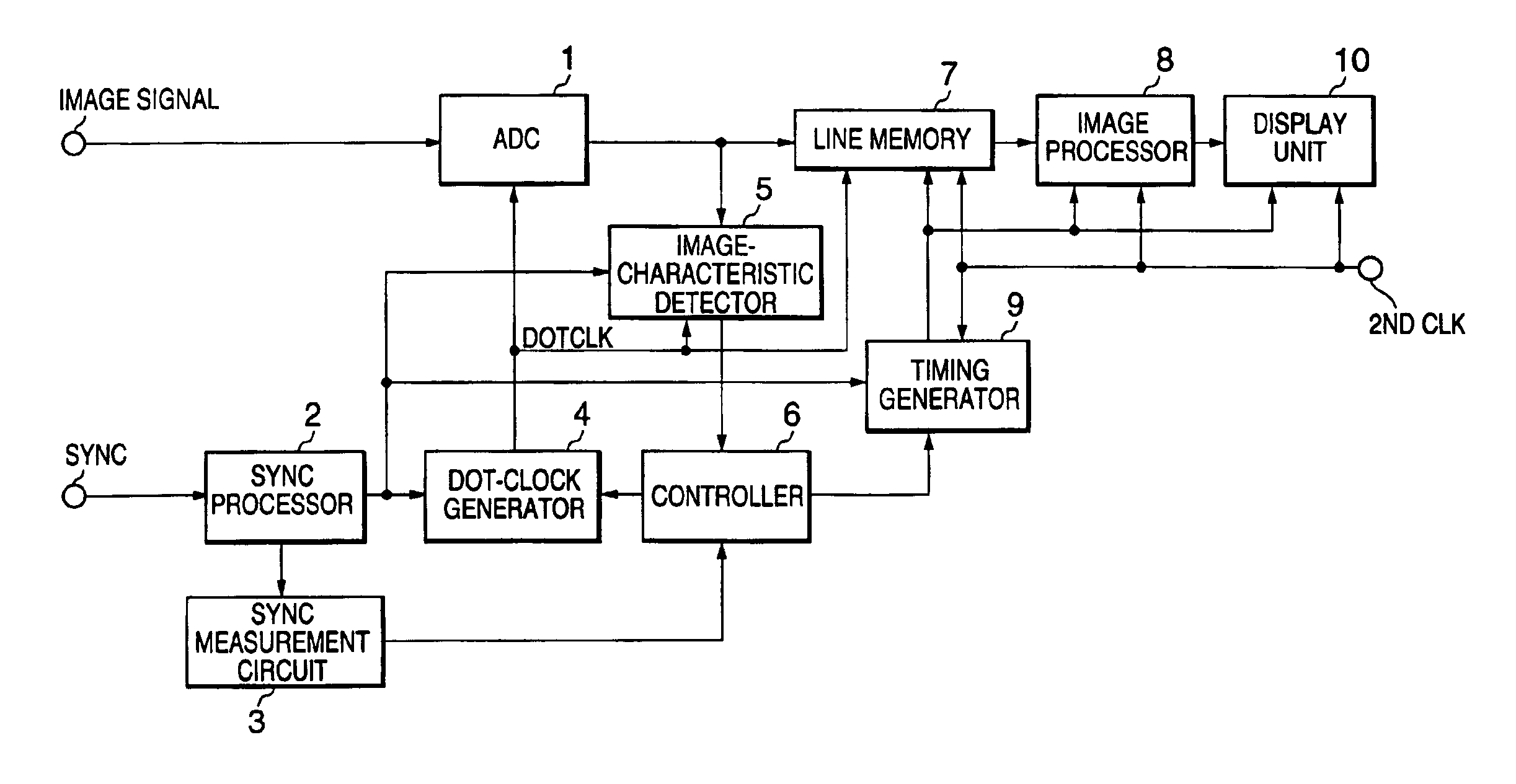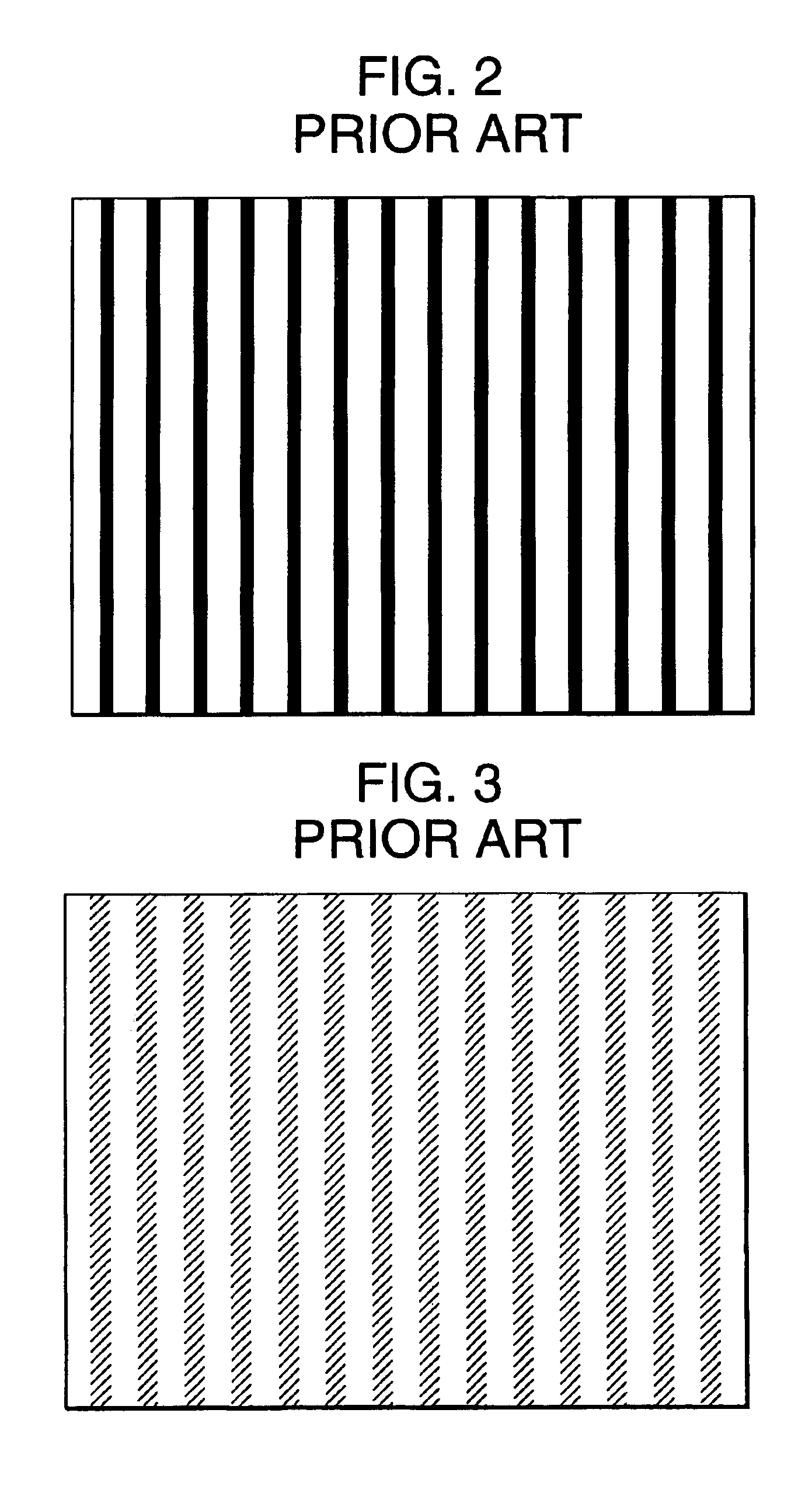Dot-clock adjustment method and apparatus for a display device, determining correctness of dot-clock frequency from variations in an image characteristic with respect to dot-clock phase
- Summary
- Abstract
- Description
- Claims
- Application Information
AI Technical Summary
Benefits of technology
Problems solved by technology
Method used
Image
Examples
first embodiment
[0044]Referring to FIG. 6, the first embodiment is a display apparatus comprising: an analog-to-digital converter (ADC) 1 that samples an input image signal in synchronization with a dot clock (DOTCLK), thereby converting the image signal to digital data; a synchronizing signal (SYNC) processor 2 that processes an input composite synchronizing signal to obtain a horizontal synchronizing signal and a vertical synchronizing signal; a synchronizing signal measurement circuit 3 that measures various properties of the horizontal and vertical synchronizing signals; a dot-clock generator 4 that generates the dot clock from the horizontal synchronizing signal; an image-characteristic detector 5 that calculates image characteristics from the image data output by the ADC 1; a controller 6 that controls the dotclock generator 4, adjusts the frequency and phase of the dot clock according to the information obtained by the synchronizing signal measurement circuit 3 and image-characteristic detec...
second embodiment
[0074]A further advantage of the second embodiment is that the characteristic curve obtained from a single pair of pixels is unlikely to be affected by clock jitter or noise.
[0075]Next, a third embodiment will be described. The third embodiment uses the maximum absolute difference characteristic to select the address used in the second embodiment.
[0076]Referring to FIG. 14, the image-characteristic detector 5 in the third embodiment comprises an absolute-difference calculator 11, an absolute-difference buffer 14, a maximum-value detector 15, and an address register 16. The maximum-value detector 15 detects the maximum absolute difference output from the absolute-difference calculator 11, as in the preceding embodiments, and also detects the address of a pair of pixels yielding this maximum absolute difference. The address register 16 stores the address detected by the maximum-value detector 15, and supplies this address to the absolute-difference buffer 14. The absolute-difference c...
third embodiment
[0081]For example, if the displayed image is a natural image with a black border, the third embodiment may select a comparatively bright pixel at an edge of the natural image and an adjacent pixel in the black border, thereby obtaining a greater absolute difference than could be obtained by selecting two pixels within the natural image itself. As a result, the characteristic curve obtained in the phase-adjustment procedure will have clearly defined maxima and minima, enabling the phase to be adjusted accurately.
[0082]In a variation of the third embodiment, instead of using the address that happens to be left in the address register 16 at the end of the frequency-adjustment procedure, the controller 6 provisionally selects a phase that maximized the maximum absolute difference characteristic, as in the first embodiment, and sets the dot clock to this phase. The image-characteristic detector 5 then measures the maximum absolute difference characteristic again, to load the address regi...
PUM
 Login to View More
Login to View More Abstract
Description
Claims
Application Information
 Login to View More
Login to View More - R&D
- Intellectual Property
- Life Sciences
- Materials
- Tech Scout
- Unparalleled Data Quality
- Higher Quality Content
- 60% Fewer Hallucinations
Browse by: Latest US Patents, China's latest patents, Technical Efficacy Thesaurus, Application Domain, Technology Topic, Popular Technical Reports.
© 2025 PatSnap. All rights reserved.Legal|Privacy policy|Modern Slavery Act Transparency Statement|Sitemap|About US| Contact US: help@patsnap.com



